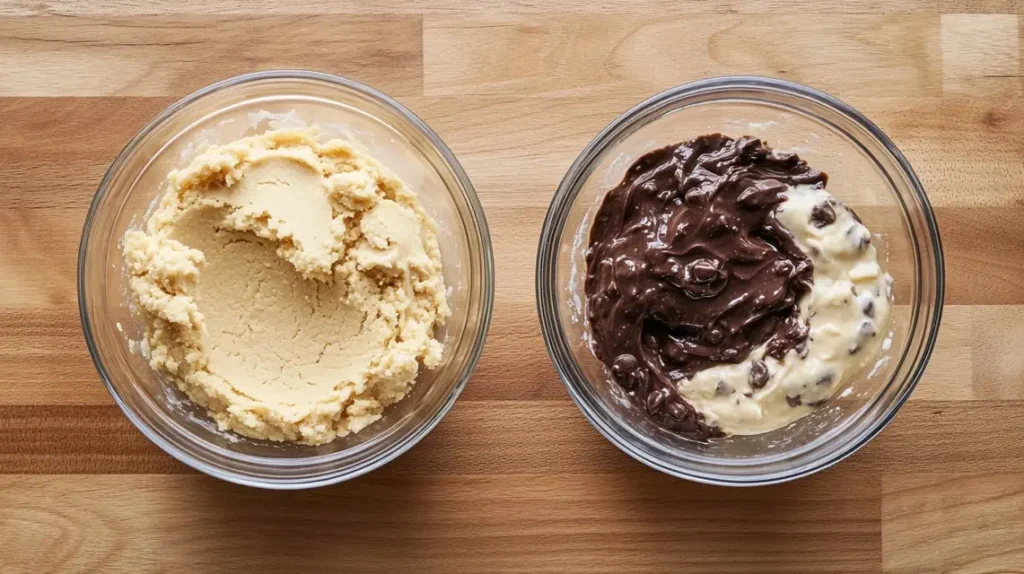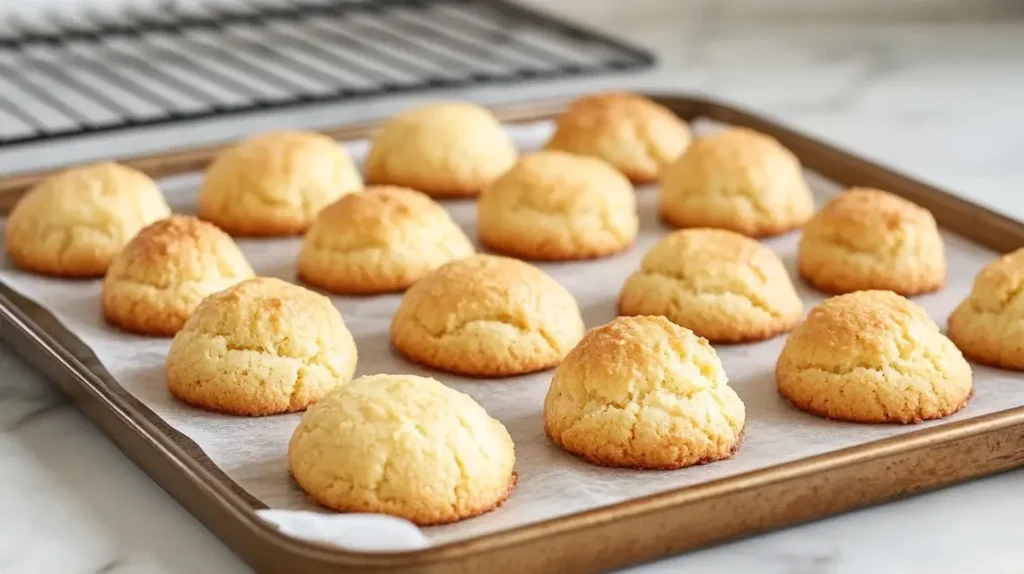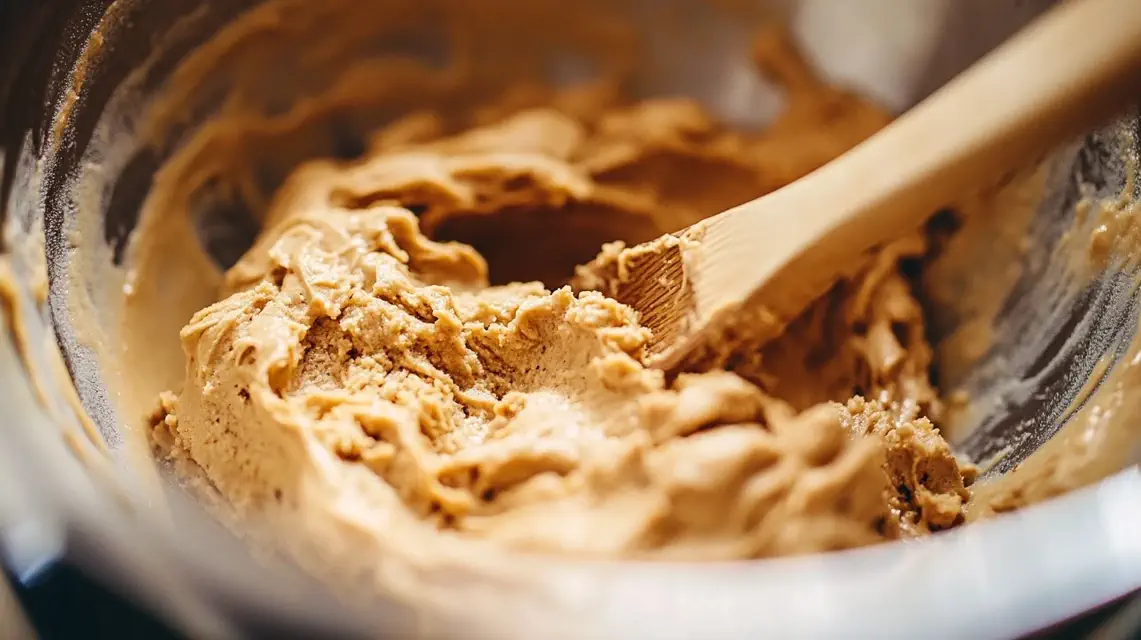Table of Contents
Introduction
Have you ever been excited to bake a batch of cookies, only to stop and think, “Why is my cookie batter like cake batter?” It’s a common frustration for bakers of all skill levels. This unexpected consistency can leave you scratching your head, wondering what went wrong. But don’t worry—you’re not alone, and the good news is that it’s usually an easy fix!
In this article, we’ll explore why your cookie batter might take on a cake-like texture, the most common baking mistakes behind it, and how to troubleshoot your dough back to cookie perfection. Whether you’re aiming for chewy chocolate chip cookies or crisp sugar cookies, understanding what’s happening in your mixing bowl is the first step to baking success. Let’s get started!
“Baking is both an art and a science. Even a tiny adjustment can lead to dramatic changes in texture and flavor.”
Understanding Cookie Batter and Cake Batter
What Is Cookie Batter?
Cookie batter is the foundation of your favorite cookies—whether it’s gooey chocolate chip, crispy sugar cookies, or oatmeal raisin classics. The batter is typically thick, with a consistency that allows you to scoop or shape it into balls or logs. It contains a balanced mix of wet ingredients (like eggs and butter) and dry ingredients (like flour and sugar) to create a solid structure.
Think of cookie batter like a sculptor’s clay—it holds its shape but can be molded. This sturdiness is what gives cookies their denser texture and chewy bite.
What Is Cake Batter?
On the flip side, cake batter is designed for lightness and airiness. It’s much runnier than cookie batter, as it needs to pour smoothly into a cake pan. Cake batter is all about rise and fluffiness, which comes from incorporating more liquid and leavening agents, such as baking powder or soda.
Picture cake batter as pancake batter’s elegant cousin—it’s silky, fluid, and eager to rise to the occasion. This key difference in consistency is what sets cookies and cakes apart.
Key Differences Between Cookie Batter and Cake Batter
When it comes to baking, understanding the differences between cookie batter and cake batter is essential to creating the perfect treat. While both start with similar basic ingredients—flour, sugar, eggs, and butter—their proportions, consistency, and preparation methods are what set them apart. Let’s dive deeper into what makes cookie batter and cake batter unique.
1. Consistency
- Cookie Batter: Cookie batter is typically thick, dense, and sturdy. It’s designed to hold its shape when scooped or rolled into balls. The thickness allows cookies to maintain their structure during baking, resulting in chewy or crispy textures depending on the recipe.
- Cake Batter: Cake batter, on the other hand, is much thinner and more fluid. Its pourable consistency is meant to spread evenly in a pan, allowing the batter to rise and create a light, fluffy texture.
2. Liquid Content
- Cookie Batter: Cookie batter uses minimal liquid, with eggs often providing most of the necessary moisture. This limited liquid content keeps the dough firm and moldable.
- Cake Batter: Cake batter requires a higher amount of liquid, such as milk, water, or buttermilk. This increased hydration is what contributes to the softer, airier structure of cakes.
3. Leavening Agents
- Cookie Batter: Cookies use smaller amounts of leavening agents, such as baking soda or baking powder, to provide a slight rise without compromising density. In some recipes, the leavening is achieved naturally through the creaming of butter and sugar.
- Cake Batter: Cakes rely heavily on leavening agents to achieve their signature rise and fluffy texture. The higher amounts of baking powder or baking soda, along with whipped eggs or other aeration techniques, are critical for light, airy cakes.
4. Fat Content
- Cookie Batter: Cookies often have a higher fat content due to the use of more butter or shortening. The fat not only adds richness but also prevents excessive gluten development, resulting in tender, crumbly cookies.
- Cake Batter: While cake batter also uses fat, it’s often balanced with liquids to create a moist but delicate crumb. The fat in cake batter plays a supporting role, rather than being the star ingredient.
5. Texture Outcome
- Cookie Batter: The final product of cookie batter is dense and chewy or crisp, depending on the baking time and fat-to-flour ratio. The goal is to create a bite-sized treat with a satisfying mouthfeel.
- Cake Batter: Cake batter is all about softness and fluffiness. The end result is light, spongy, and designed to hold layers or frosting.
6. Sugar Ratios
- Cookie Batter: Cookie recipes typically call for higher sugar content, which caramelizes during baking and contributes to the crisp edges and chewy centers we love in cookies.
- Cake Batter: Cakes also rely on sugar but in more balanced proportions with other ingredients. The sugar contributes to sweetness and moisture without creating a chewy texture.
7. Handling and Preparation
- Cookie Batter: Cookie dough is often manipulated by hand—scooped, rolled, or shaped into logs before baking. This makes it easier to control the size and shape of individual cookies.
- Cake Batter: Cake batter is typically poured or spread evenly into a pan, ensuring a smooth, level surface for even baking and decorating.
Summary Table of Key Differences
| Aspect | Cookie Batter | Cake Batter |
|---|---|---|
| Consistency | Thick and moldable | Thin and pourable |
| Liquid Content | Low | High |
| Leavening Agents | Minimal | Abundant |
| Fat Content | High (butter/shortening-heavy) | Balanced with liquids |
| Texture Outcome | Dense, chewy, or crisp | Light, fluffy, and spongy |
| Sugar Ratios | Higher (caramelized for texture) | Balanced for sweetness and moisture |
| Handling | Shaped by hand | Poured or spread into a baking pan |
By understanding these differences, you’ll be better equipped to diagnose and fix batter mishaps, ensuring that your cookies stay cookies—and your cakes remain fluffy masterpieces.

Over-mixing your cookie batter incorporates too much air, giving it a fluffy, cake-like texture. Use a gentle hand when combining ingredients, particularly after adding the flour. Over-mixing is a frequent mistake, as described in our guide on the difference between cookie and cake batter.
Common Reasons Why Cookie Batter Resembles Cake Batter
Overmixing the Ingredients
One of the sneakiest culprits behind cake-like cookie batter is overmixing. When you overwork your dough, you activate too much gluten in the flour, resulting in a more elastic texture—perfect for bread, but not for cookies. Overmixing can also whip excessive air into the batter, making it puffier and more akin to cake batter.
Remember this: mixing is like a handshake—it should be firm but not aggressive. Stir until just combined, and let the ingredients do the rest of the magic.
Using Too Much Liquid
Cookies thrive on balance. If you accidentally add too much liquid—whether it’s milk, eggs, or even vanilla extract—your batter can quickly turn runny. A little extra liquid can transform thick cookie dough into something closer to cake batter.
Think of it as watering down soup. A splash too much, and suddenly, your hearty stew is a broth. Measure your liquids carefully and avoid eyeballing them unless you’re a baking wizard!
Excessive Use of Leavening Agents
Baking powder and baking soda are powerful players in the kitchen, but too much of a good thing can backfire. Overloading your recipe with leavening agents will make your cookies rise like a soufflé, giving them that airy, cake-like texture.
“In baking, less is often more. Stick to the recipe’s specified measurements for leavening agents.”
Incorrect Ratio of Dry to Wet Ingredients
If your ratio of dry ingredients (like flour and cocoa powder) to wet ingredients (like butter and eggs) is off, your batter might lose its structure. Too little flour and too much wetness equals a batter that struggles to hold its shape—hello, cake batter!
Imagine building a sandcastle with soggy sand. Without the right balance, it collapses—and so does your cookie dough consistency.
Temperature of Butter or Other Ingredients
Butter is a star in cookie dough, but if it’s melted or too soft, it can make your batter too liquidy. Warm butter integrates poorly into the dry ingredients, turning your dough into a cake batter impersonator.
Pro tip: Use room-temperature butter. It should be soft enough to press with a finger but not so soft that it’s gooey.
Using the Wrong Type of Flour
Not all flours are created equal. If you use cake flour instead of all-purpose flour, your cookies will be softer and more tender—great for cakes, not for cookies. Cake flour has less protein, which means less gluten development, leading to fluffier results.
Stick to the recipe’s recommended flour type, and you’ll avoid unnecessary surprises.
Troubleshooting and Solutions to Fix Cookie Batter
Adjusting Ingredient Ratios
Did your batter already go rogue? No worries! If it’s too thin, add a tablespoon of flour at a time until it reaches a scoopable consistency. On the other hand, if it’s too thick, a splash of milk or water can bring it back to life. Easy fixes save the day!
Proper Mixing Techniques
Be gentle with your mixing. Use a wooden spoon or rubber spatula and stir just until the ingredients combine. Overmixing introduces unwanted air, so treat your batter like a delicate piece of art.
Controlling Liquid Additions
If your recipe calls for optional liquid ingredients like milk or heavy cream, start with smaller amounts. You can always add more if needed, but once it’s too liquidy, there’s no going back!
Choosing the Right Flour
If you accidentally used the wrong flour type, try mixing in a bit of all-purpose flour to stiffen the batter. Remember, it’s not an exact science, but you can salvage most mistakes with a little creativity.
Maintaining Ingredient Temperatures
Cold ingredients can mess with your batter consistency, while overly warm ingredients might turn it into a puddle. Keep everything at room temperature unless otherwise specified in the recipe. Consistency is key!
Tips to Prevent Cookie Batter from Turning Into Cake Batter
Measuring Ingredients Accurately
Precision is the secret sauce of baking. Use measuring cups and spoons for dry and liquid ingredients, and level off with a knife for accuracy. Trust me, this tiny step saves you from massive headaches later.
Following Recipes Closely
Baking isn’t the time to wing it. Recipes are like roadmaps, guiding you toward delicious results. Stick to the instructions until you’re confident enough to experiment.
Avoiding Common Mixing Mistakes
Remember, less is more when it comes to mixing. Combine your dry and wet ingredients gently and stop as soon as everything looks incorporated. Think of it as folding laundry—you don’t need to overdo it.
Frequently Asked Questions
What Can I Do If My Cookie Batter Is Already Like Cake Batter?
If your batter’s too thin, don’t panic! Add more flour, chill the dough, or reduce the liquid. Small adjustments can work wonders. Worst case? Bake it anyway—sometimes happy accidents lead to tasty creations!
Can I Use Cake Batter to Make Cookies?
Yes, but don’t expect traditional cookies. Cake batter cookies are usually soft and fluffy, resembling little cakes rather than crispy treats. Embrace the experiment and enjoy the process.
Does Overmixing Always Cause Problems?
Expert Tips for Perfect Cookie Batter Every Time
Understanding the Science Behind Baking
Let’s get a little nerdy for a second. Baking is essentially a series of chemical reactions. Each ingredient in your cookie batter plays a role in creating that perfect texture. For example, butter provides richness, sugar caramelizes to create sweetness and crunch, and eggs bind everything together.
When you understand the role of each ingredient, you can start to identify where things go wrong. For instance, too much liquid will break down the structure, while too much leavening will make the dough puff up and collapse.
“Think of baking like conducting a symphony—every ingredient needs to hit the right note for a harmonious result.”
How to Experiment Safely With Recipes
Once you’ve mastered the basics, experimenting with cookie recipes can be super fun. Want to swap out all-purpose flour for almond flour? Go for it! But make sure to adjust other ingredients to balance the moisture and structure.
A good rule of thumb? Make small changes at a time. If you’re adding something wet, like a fruit puree, reduce another liquid in the recipe. This way, you’ll keep your batter from turning into a cake batter disaster.
Chilling the Dough for Better Results
Ever notice how some recipes call for chilling the dough? This step is a game-changer! Cold dough is firmer and less likely to spread while baking, leading to thicker, chewier cookies. If your batter is too soft or cake-like, pop it in the fridge for 30 minutes—it works wonders!
The Role of Temperature in Baking
Your oven’s temperature is just as important as your ingredient ratios. If your cookies bake at too low a temperature, they won’t set properly and might come out spongy. Invest in an oven thermometer to ensure accuracy, as some ovens can run hotter or cooler than they claim.
Knowing When to Trust Your Instincts
Recipes are great, but don’t forget to trust your instincts. If the batter feels too runny, don’t hesitate to add more flour. If it seems too stiff, a splash of milk can make a big difference. With practice, you’ll develop a feel for what works best!
Leavening agents like baking powder or baking soda are essential in baking, but too much can make your cookies puff up like cakes. Learn more about achieving the perfect balance of ingredients by exploring tips in cake mix cookies recipes.

Conclusion
Baking cookies should be fun, not stressful. If your cookie batter ends up resembling cake batter, it’s not the end of the world. By understanding the common causes—like too much liquid or overmixing—and applying the solutions and tips we’ve discussed, you can confidently tackle any batter mishap.
Remember, even professional bakers make mistakes. The key is to learn from them and enjoy the process. After all, whether your cookies turn out cakey or chewy, they’re still homemade and delicious. So, grab your apron, get baking, and don’t forget to share your creations with friends and family!

